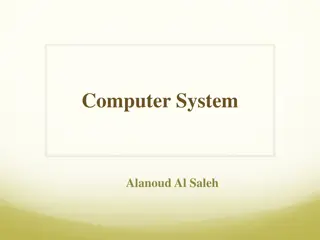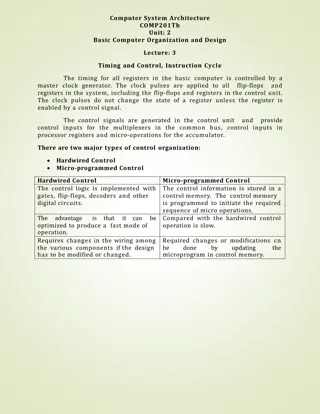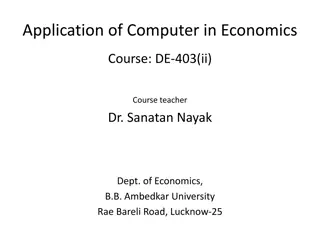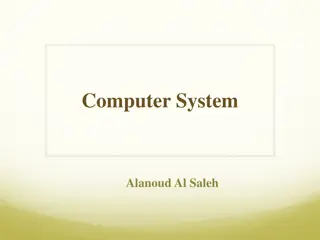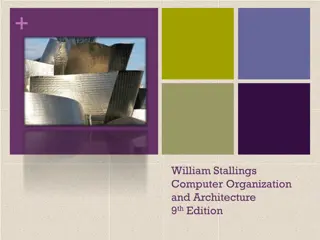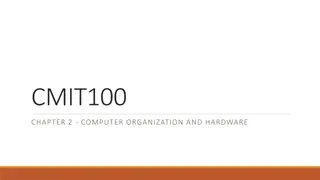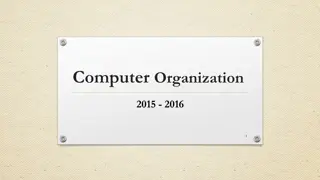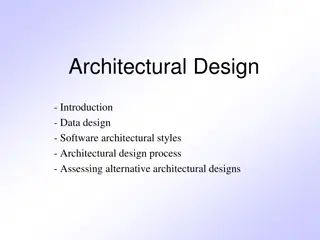Understanding Computer Organization and Design: Chapter 2
This content discusses shift operations, AND operations, OR operations, EOR operations, and conditional operations in computer organization and design. It covers topics such as shifting logical operations, masking bits, including bits, differencing operations, and conditional branching instructions, providing a comprehensive overview of the hardware/software interface.
Download Presentation

Please find below an Image/Link to download the presentation.
The content on the website is provided AS IS for your information and personal use only. It may not be sold, licensed, or shared on other websites without obtaining consent from the author. Download presentation by click this link. If you encounter any issues during the download, it is possible that the publisher has removed the file from their server.
E N D
Presentation Transcript
COMPUTER ORGANIZATIONAND DESIGN The Hardware/Software Interface Chapter 2 Chapter 2 Instructions: Language of the Computer
Shift Operations opcode Rm shamt Rn Rd 11 bits 5 bits 6 bits 5 bits 5 bits shamt: how many positions to shift Shift left logical Shift left and fill with 0 bits LSL by i bits multiplies by 2i Shift right logical Shift right and fill with 0 bits LSR by i bits divides by 2i (unsigned only) 2
AND Operations Useful to mask bits in a word Select some bits, clear others to 0 AND X9,X10,X11 X10 00000000 00000000 00000000 00000000 00000000 00000000 00001101 11000000 X11 00000000 00000000 00000000 00000000 00000000 00000000 00111100 00000000 00000000 00000000 00000000 00000000 00000000 00000000 00001100 00000000 X9 3
OR Operations Useful to include bits in a word Set some bits to 1, leave others unchanged OR X9,X10,X11 X10 00000000 00000000 00000000 00000000 00000000 00000000 00001101 11000000 X11 00000000 00000000 00000000 00000000 00000000 00000000 00111100 00000000 00000000 00000000 00000000 00000000 00000000 00000000 00111101 11000000 X9 4
EOR Operations Differencing operation create a 0 when bits are the same and a 1 if they are different the equivalent to NOT is an EOR 111 111 EOR X9,X10,X12 // NOT operation 00000000 00000000 00000000 00000000 00000000 00000000 00001101 11000000 X10 X12 11111111 11111111 11111111 11111111 11111111 11111111 11111111 11111111 11111111 11111111 11111111 11111111 11111111 11111111 11110010 00111111 X9 5
Conditional Operations Branch to a labeled instruction if a condition is true Otherwise, continue sequentially CBZ register, L1 if (register == 0) branch to instruction labeled L1; Compare and branch if zero CBNZ register, L1 if (register != 0) branch to instruction labeled L1; Compare and branch if not zero B L1 branch unconditionally to instruction labeled L1; 6
Compiling If Statements C code: if (i==j) f = g+h; else f = g-h; f, g, in X22, X23, Compiled LEGv8 code: SUB X9,X22,X23 // X9 = i j CBNZ X9,Else // go to Else if i j (X9 0) ADD X19,X20,X21 // f = g + h (skipped if i j) B Exit // go to Exit Else: SUB X9,X22,x23 // f = g h Exit: Assembler calculates addresses 7
Compiling Loop Statements C code: while (save[i] == k) i += 1; i in x22, k in x24, address of save in x25 Compiled LEGv8 code: Loop: LSL X10,X22,#3 // Temp reg X10 = i * 8 ADD X10,X10,X25 // X10 = address of save[i] LDUR X9,[X10,#0] // Temp reg X9 = save[i] SUB X11,X9,X24 // X11 = save[i] k CBNZ X11,Exit // go to Exit if save[i] k(X11 0) ADDI X22,X22,#1 // i = i + 1 B Loop // go to Loop Exit: 8
Basic Blocks A basic block is a sequence of instructions with No embedded branches (except at end) No branch targets (except at beginning) A compiler identifies basic blocks for optimization An advanced processor can accelerate execution of basic blocks 9
More Conditional Operations Condition codes, set from arithmetic instruction with S- suffix (ADDS, ADDIS, ANDS, ANDIS, SUBS, SUBIS) negative (N): result had 1 in MSB zero (Z): result was 0 overlow (V): result overflowed carry (C): result had carryout from MSB Use subtract (A-B) to set flags, then conditionally branch: 10
Conditional branches LEGv8 includes four branches to complete the testing of the individual condition code bits: Branch on minus (B.MI): N=1; Branch on plus (B.PL): N=0; Branch on overflow set (B.VS): V=1; Branch on overflow clear (B.VC): V=0. An alternative to condition codes: have instructions that compare two registers and then branch based on the result. compare two registers and set a third register to a result indicating the success of the comparison, which a subsequent conditional branch instruction then tests to see if register is non- zero (condition is true) or zero (condition is false). Conditional branches in MIPS follow the latter approach 11
Conditional Example if (a > b) a += 1; a in X22, b in X23 SUBS X9,X22,X23 // use subtract to make comparison B.LTE Exit // conditional branch ADDI X22,X22,#1 Exit: 12
Signed vs. Unsigned Signed comparison Unsigned comparison Example X22 = 1111 1111 1111 1111 1111 1111 1111 1111 X23 = 0000 0000 0000 0000 0000 0000 0000 0001 X22 < X23 # signed 1 < +1 X22 > X23 # unsigned +4,294,967,295 > +1 13
2.8 Supporting Procedures in Computer Hardware Procedure Calling Steps required 1. Place parameters in registers X0 to X7 2. Transfer control to procedure 3. Acquire storage for procedure 4. Perform procedure s operations 5. Place result in register for caller 6. Return to place of call (address in X30) 14
Procedure Call Instructions Procedure call: branch-and-link instruction BL ProcedureLabel Address of following instruction put in LR (X30) Jumps to target address Procedure return: branch register instruction BR LR Copies LR (X30) to program counter Can also be used for computed jumps e.g., for case/switch statements Program Counter (PC): register containing the address of the current instruction BL saves PC+4 in register LR 15
Leaf Procedure Example C code: long long int leaf_example (long long int g, long long int h, long long int i, long long int j) { long long int f; f = (g + h) - (i + j); return f; } Arguments g, , j in X0, , X3 f in X19 (hence, need to save $s0 on stack) 16
Leaf Procedure Example LEGv8 code: leaf_example: SUBI SP,SP,#24 STUR X10,[SP,#16] STUR X9,[SP,#8] STUR X19,[SP,#0] ADD X9,X0,X1 ADD X10,X2,X3 SUB X19,X9,X10 ADD X0,X19,XZR LDUR X10,[SP,#16] LDUR X9,[SP,#8] LDUR X19,[SP,#0] ADDI SP,SP,#24 BR LR Save X10, X9, X19 on stack X9 = g + h X10 = i + j f = X9 X10 copy f to return register Resore X10, X9, X19 from stack Return to caller 18
Register Usage X9 to X17: temporary registers Not preserved by the callee X19 to X28: saved registers If used, the callee saves and restores them Two stores and two loads can be dropped from the code. Still must save and restore X19 19
Non-Leaf Procedures Procedures that call other procedures For nested call, caller needs to save on the stack: Its return address Any arguments and temporaries needed after the call Restore from the stack after the call 20
Non-Leaf Procedure Example C code: int fact (int n) { if (n < 1) return f; else return n * fact(n - 1); } Argument n in X0 Result in X1 21
Leaf Procedure Example LEGv8 code: fact: SUBI SP,SP,#16 STUR LR,[SP,#8] STUR X0,[SP,#0] // save the argument n SUBIS XZR,X0,#1 B.GE L1 ADDI X1,XZR,#1 ADDI SP,SP,#16 BR LR L1: SUBI X0,X0,#1 BL fact LDUR X0,[SP,#0] LDUR LR,[SP,#8] ADDI SP,SP,#16 MUL X1,X0,X1 BR LR Save return address and n on stack // save the return address test for n < 1 if n >= 1, go to L1 Else, set return value to 1 Pop stack, don t bother restoring values Return n = n - 1 call fact(n-1) Restore caller s n Restore caller s return address Pop stack return n * fact(n-1) return 22





